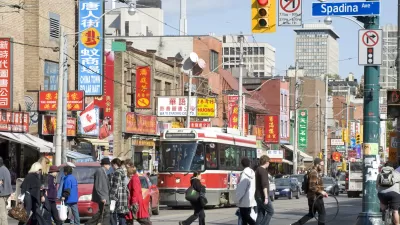Simply put, this scholar says, it comes down to race. With far fewer non-white urban residents, Canadian cities didn't fall prey to the redlining, white flight, and incarceration problems that so heavily impacted cities like Detroit.

According to Jason Hackworth, a professor of urban geography at the University of Toronto, there's one big difference why cities like Detroit suffered while Canadian cities like Toronto did not, despite their similar economies.
John Gallagher writes, "The more [Hackworth] looked, the more one big difference between Canada and the United States emerged: It came down to race. Put simply, U.S. cities tend to have large black and other non-white populations and Canadian cities do not." In U.S. cities, an influx of non-whites led to a white backlash, encompassing flight to the suburbs, redlining, biased criminal justice practices, and the like. Compounded with economic decline, those factors landed cities like Detroit in deep trouble.
Historical Canadian policy, on the other hand, "made sure black and other non-white populations remained small. Restrictive covenants in real estate sales, and an immigration policy that specifically gave preference to white people, kept the black population small."
Gallagher concludes, "Simply put, in Canada, white people never felt as threatened by a rising non-white population because there just weren't that many non-whites coming into cities like Windsor or Toronto. Hence, no Detroits in Canada."
FULL STORY: Why Canadian cities didn't suffer as Detroit did

Alabama: Trump Terminates Settlements for Black Communities Harmed By Raw Sewage
Trump deemed the landmark civil rights agreement “illegal DEI and environmental justice policy.”

Study: Maui’s Plan to Convert Vacation Rentals to Long-Term Housing Could Cause Nearly $1 Billion Economic Loss
The plan would reduce visitor accommodation by 25% resulting in 1,900 jobs lost.

Planetizen Federal Action Tracker
A weekly monitor of how Trump’s orders and actions are impacting planners and planning in America.

Wind Energy on the Rise Despite Federal Policy Reversal
The Trump administration is revoking federal support for renewable energy, but demand for new projects continues unabated.

Passengers Flock to Caltrain After Electrification
The new electric trains are running faster and more reliably, leading to strong ridership growth on the Bay Area rail system.

Texas Churches Rally Behind ‘Yes in God’s Back Yard’ Legislation
Religious leaders want the state to reduce zoning regulations to streamline leasing church-owned land to housing developers.
Urban Design for Planners 1: Software Tools
This six-course series explores essential urban design concepts using open source software and equips planners with the tools they need to participate fully in the urban design process.
Planning for Universal Design
Learn the tools for implementing Universal Design in planning regulations.
Caltrans
Smith Gee Studio
Institute for Housing and Urban Development Studies (IHS)
City of Grandview
Harvard GSD Executive Education
Toledo-Lucas County Plan Commissions
Salt Lake City
NYU Wagner Graduate School of Public Service





























